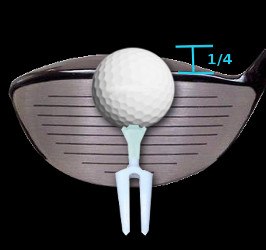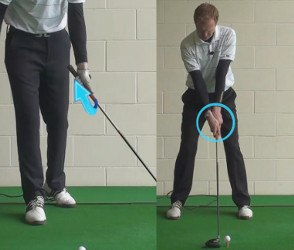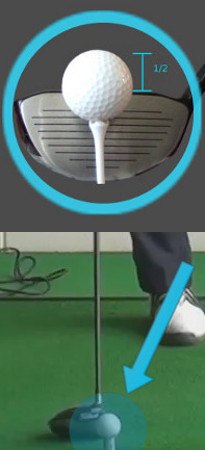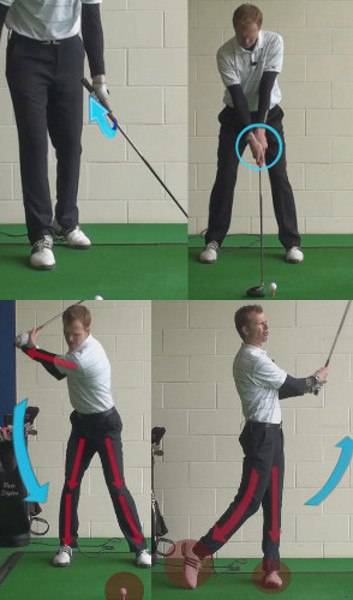
Conventional wisdom dictates that when facing an extremely narrow fairway, you should hit a fairway wood, a hybrid or even an iron instead of the driver. But sometimes you need more distance than any of those clubs can supply; for example, if you're facing a long par 4.
When that's the case, approach the situation as though you're “between clubs” on an approach shot and decide to hit the longer club with an easier swing. Or think of it like an iron shot played into the wind. The idea is to take a little something off it, like a pitcher changing the speed of his fastball.

For those times when you absolutely, positively must find the fairway with your driver, make these three simple adjustments:
- Tee the ball lower: For a typical drive, about half the ball should be above the club's top line. To improve accuracy, push it down to where just a small portion – no more than a quarter of the ball – appears above the club. Play the ball opposite your left heel, same as for a normal drive, because moving it back in your stance can cause a descending blow and a pop-up.
- Grip down on the club: Place your hands about two inches lower on the grip than usual. Shortening the shaft enhances your control of the club, tightens up your swing and reduces the chances of the ball veering wildly off line.
- Make an easy swing: This isn't the time to “grip it and rip it.” Swing at about 80 percent of your typical effort, focusing on a smooth tempo from start to finish. Combined with the other adjustments, the easy swing will produce a lower ball flight that won't carry as far as a full-speed drive, but will curve less and roll farther.
Here's a final key: When you've got to put driver in the fairway, think “low” low tee height, low hands on the club, low swing speed, low trajectory. The result: higher accuracy.

Top Ways to Hitting Tight Fairways with the Driver
It is hard to feel confident when you stand on the tee and see a narrow fariway in front of you. Even if you are normally consistent with your driver, facing a tight fairway can quickly eat away at the confidence that you have built up over the years. Of course, if you are going to post good scores, you need to be able to hit tight fairways on a consistent basis, as most courses have at least a few narrow driving holes. Whether the course you are playing guards its fairways with water, trees, bunkers, or some other form of hazard, your job is the same – to put your ball right in the middle of the short grass to set up an easy approach.
For some golfers, facing a tight fairway means immediately putting away the driver in favor of a long iron or fairway wood. While that is an option, especially on shorter holes, you also want to be able to hit a narrow fairway with your driver from time to time. If you face a long par four with a tight fairway, for example, you don't want to sacrifice distance by putting your driver back in the bag. When a long and accurate drive is going to be required, your only choice is to use the driver and make a great swing.
Fortunately, it is possible to conquer this challenge through a combination of solid fundamentals and good course management strategy. While you are never going to be perfect with the driver – everyone misses fairways from time to time – you can develop a consistent level of performance by having a good plan each time you stand over the ball. That is really what the content below is going to be all about – making sure you have a clear plan in place for how you are going to hit narrow fairways with the driver. Some of the tips will be physical in nature, but most of them will be related to the mental game. When you think clearly as you make your way around the course, you stand the best chance to succeed. Golf is very much a mental challenge, and those who are able to rise to that part of the challenges are the players who will come out on top.
Before getting into the various strategies that you can use to hit tight fairways with the driver, there is one point that needs to be made straight away – you have to have confidence when hitting your drives. Even if you are facing a tight fairway, you can't make a scared swing. Well, you can, but you are not going to like the results. Once you have your plan in place and you take your stance, all of the potential negative outcomes for the shot need to leave your brain. At this point, you can only be thinking about success – picture the ball heading directly for your target, and then make it happen. Good planning and physical execution are important, but thinking positively and having confidence are hugely important as well.
All of the instruction contained below is based on a right handed golfer. If you happen to play left handed, please take a moment to reverse the directions as necessary.

Tee It Low for Control
One of the key physical adjustments you can make in order to become more accurate with your driver is simply to tee the ball lower than usual. When hitting your driver, you should typically be teeing the ball up so that half of the ball is above the level of the top of the driver at address. This is a good tee height to optimize distance, as it will allow you to hit up aggressively through the shot. However, when you want to prioritize accuracy over distance, you should alter that setup by pushing your tee a bit farther into the ground. For drives to narrow fairways, try teeing the ball up so that only a tiny portion of the top of the ball is above the top line of your driver. You are going to naturally lose a bit of yardage off of your drives when making this adjustment, but the gain in accuracy will be more than worth it.
To get started using this tip, the best thing you can do is hit some drives on the practice range while using a lower tee height to see how the ball responds. While your general pattern should be straighter with less dispersion, you might notice some changes in your ball flight from your usual drives. Specifically, it is likely that you will be more prone to hitting a cut than you are when hitting the ball off of a higher tee. So, for example, a player who usually hits a draw with the driver might find that the ball wants to cut – or at least wants to fly straighter – when the tee is pushed farther into the earth. Since there will be less room under the ball at impact, you will not be able to attack from as far on the inside, meaning a draw is less likely. This is not a problem, however, as long as you adjust your aim accordingly.
Since the ball is going to be closer to the ground at impact with this strategy, you need to do a great job of keeping your head as still as possible throughout the swing. Remember, the emphasis with this kind of shot is on control rather than power, so don't worry about making a huge backswing. Instead, keep your head very still and your eyes on the ball at all times. As long as you make a clean strike at the bottom, you will find that you get plenty of distance out of the shot as it flies straight down the fariway.
If you are having trouble making the adjustment to hitting your driver with a lower tee height, you may need to move the ball back slightly in your stance. Most players position the ball well-forward in the stance with a normal tee height, which is a good thing, but that kind of ball position can pose problems with a lower tee. You don't want to be hitting the ball on the upswing in this case, so moving the ball back just a couple of inches can help you to find the sweet spot more regularly. Experiment with ball position on the range until you find a spot that promotes the perfect ball flight for your drives.

Use Less of the Club
Another successful, but often-overlooked method of being more accurate with your driver is simply choking down on the shaft of the club. When you use less of the club in your swing, you will have a better chance of hitting the sweet spot at impact – and hitting the sweet spot is really the key to producing accurate drives. You don't have to choke down on the grip significantly to see improvements, either. Just come down by an inch or two as you are taking your address position and then make your normal swing. The shorter effective length of the shaft will make it easier for you to make good contact, and you might be surprised to see how far the ball still flies even when you choke down.
Of course, you can't just move your hands down on the shaft of the club and make a swing without first making a couple of other adjustments. First, you are going to need to stand closer to the ball at address. This only makes sense, of course, since the club is effectively shorter than it would be if you had your hands all the way up at the top. The club is probably about the length of a three wood at this point, so stand in a position similar to that which you would use for a three wood shot and you should be ready to go. In the end, you should feel like you are a comfortable distance from the ball at address, and you shouldn't feel like you are reaching out awkwardly to put the club behind the ball.
Be sure to practice hitting at least a few drives with this method before you put it to use out on the course. One of the problems that some players run into when they choke down on the club is rushing through the swing – especially at the top. Since the club will feel lighter in your hands, and you won't need to make as long of a swing to get it around your body, you might feel like you can rush through the swinging action. Of course, that would be a mistake. You need to take your time during your swing, allowing everything to build up naturally until you are ready to swing down into the back of the ball. You will be far more accurate with your drives when you maintain a smooth tempo from start to finish, so don't let the fact that you have choked down on the grip alter the way you swing the club.
Also, be sure that you still accelerate the club through the hitting area to a full finish when you are choked down on the grip. Some golfers feel like this needs to be a 'half swing', so they will ease up on the speed of the swing at the bottom in an attempt to guide the ball into the fariway. This is an unnecessary adjustment that will almost certainly lead to trouble. Instead, you should be swinging confidently through the ball, trusting the fact that using less of the club is going to help you gain control even with an aggressive swing. The whole point of choking down in the first place was to allow you to swing hard while still controlling the ball. Don't ruin that idea by backing off on your swing at the last moment prior to impact. Keep the speed up, swing through with confidence, and watch the ball sail right down the middle time after time.

Find the Forgiving Side
With the physical tips out of the way – altering your tee height and moving your grip – we can now get into some of the strategic changes that you can make to improve your chances of hitting a tight fariway. One of the best ways to keep your ball in play on a tight hole is to find the forgiving side of the fairway and then use that as your target. Even on a narrow hole, there is very likely going to be one side of the fairway that is more forgiving than the other. If you are able to point your drive in that direction, you should be able to set up at least a decent look at your approach shot.
The first thing to think about when looking for the forgiving side of the hole are any hazards that are lurking around the fairway. Is there water on one side of the hole? Is one side protected by out of bounds stakes? Asking yourself these questions is a good start to developing a sound strategy. Quite obviously, you want to keep your ball away from any hazards that are in play, so you will immediately be looking to the opposite side of the fairway if there are potential penalty strokes waiting to punish a mistake. Even something like a deep bunker, while it doesn't offer a penalty stroke, is enough of a threat to make you want to steer clear into the other side of the fairway.
Another piece of this puzzle is any dogleg that is present in the design of the hole you are facing. Does the fairway turn to the right or left as it heads to the green? If so, you are going to want to play to the outside of the dogleg to give yourself the most margin for error. If you were to try to hit the inside of the dogleg, and you happen to miss your line even by a small amount, you might find that you don't have any shot toward the green. Instead, take a line that heads down the wide side of the dogleg to make it more likely that you will have a shot to the green. Even if your drive doesn't come off perfectly, using that wide side will open up angles to the hole that would not have existed on the inside of the dogleg.
When trying to hit a narrow fairway, you need to keep in mind the fact that putting your ball in the rough isn't always a big deal. For instance, if you are playing a course with relatively light rough and greens that are on the softer side, playing your approach shot from the rough is unlikely to cause much of a problem. This is a point that plays into the previous point regarding aiming for the wide side of the dogleg. If you have the choice of playing from the rough with an angle to the green or being in the fairway but having no shot at the hole, playing from the rough is the easy pick.
The goal of your tee shot should always be to set up the easiest second shot possible, and sometimes that may mean putting your ball in the rough on the side of the fariway with the best look at the target. Hitting the fairway won't do you any good if you are blocked out, so take a close look at the shape of the hole from the tee and take the line that you feel will offer you the best chance to wind up putting for birdie. If that means hitting your tee shot in the rough, then so be it – as long as the rough isn't particularly deep or thick, you should still have a chance to hit the green in regulation.

Control Your Curve
Perhaps the best way of all to hit a tight fariway when swinging your driver is to control the curve of your golf ball to match the hole you are playing. Having the ability to hit a draw or a fade on command is a huge advantage on the golf course, and that advantage is never more important then when you are trying to split a narrow fairway with the longest club in your bag. Nearly every hole you encounter will favor either a draw or a fade, so it is your job to figure out which is the better option. Once you pick out the right shot for the situation, having the ability to execute that shot time after time is what will separate the average golfers from the good ones.
So how do you know which way you should be curving the ball? The first thing you want to do is check the shape of the hole along with the condition of the turf. You need to match up your strategy to both of these elements if you want to be successful as often as possible. Use the following points to figure out how you should curve the ball based on the situation that you are facing on the course.
- Firm Conditions = Follow the Shape. When the ground is firm and the ball is bouncing and rolling after it lands, you will want to match the shape of the hole to the best of your ability. This means that you should be trying to curve the ball from left to right when the hole bends to the right, and you should be turning it over from right to left when the fairway takes a left turn. By matching your ball flight to the shape of the hole, you will be allowing the ball to bounce and run out in the correct direction. Of course, you aren't going to hit every single fairway when you use this plan, but you should be successful more often than not.
- Soft Conditions = Turn the Ball into the Dogleg. If the ground is soft around the golf course, you are going to want to take the opposite plan as the one you used above. In this case, you are going to turn your ball in the opposing direction to the path of the dogleg. So, if you are playing a hole that has a dogleg right, you are going to turn the ball from right to left in order to hit 'into' the curve (assuming there are no trees in your way, of course). Or, if the hole doglegs to the left, do your best to hit a fade back into the fairway. This plan is effective in soft conditions because you don't have to worry about the ball running through the fairway after it lands. Without the run out to cause problems, you can curve the ball into the dogleg to maximize your distance and set up the shortest second shot possible.
Obviously, you will have to have the ability to curve the ball on demand if you are going to use this strategy effectively. On the range, work on hitting both fades and draws on demand, and only try to use them on the course when you can reliably produce them first on the practice tee. It isn't as hard as you might think to learn how to turn the ball in both directions, but it certainly does take practice.
Hitting a narrow fairway with your driver isn't always easy – but it isn't impossible, either. You should still club down on the tee of narrow holes when you can, such as on short par fours, but you don't always have to run away from the driver when the fairways get tight. Use the tips above to give yourself a great chance to find the short grass, and then make a confident swing all the way through to a full finish.





